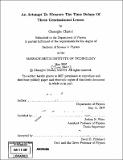| dc.contributor.advisor | Joshua N. Winn. | en_US |
| dc.contributor.author | Chistol, Gheorghe | en_US |
| dc.contributor.other | Massachusetts Institute of Technology. Dept. of Physics. | en_US |
| dc.date.accessioned | 2008-03-27T18:21:55Z | |
| dc.date.available | 2008-03-27T18:21:55Z | |
| dc.date.copyright | 2007 | en_US |
| dc.date.issued | 2007 | en_US |
| dc.identifier.uri | http://hdl.handle.net/1721.1/40906 | |
| dc.description | Thesis (S.B.)--Massachusetts Institute of Technology, Dept. of Physics, 2007. | en_US |
| dc.description | Includes bibliographical references (p. 95-97). | en_US |
| dc.description.abstract | I present the results of reduction and analysis of two seasons of gravitational lens monitoring using the Very Large Array (VLA) at 8.5 GHz. The campaign monitored five gravitational lenses, GL1608, GL1830, GL1632, GL1838, and GL2004 from 24 January 2002 until 18 September 2002, and from 21 May 2003 until 29 January 2004. In addition to gravitational lenses, the campaign monitored ten flux and phase calibrators. The goal of this work was to measure the gravitational lens time delays. The ultimate goal was to estimate H₀ in a one-step calculation as proposed by Refsdal in 1964 [30]. I reduced the data using AIPS and DIFMAP astronomical data processing software. I analyzed the final light curves in MATLAB using Pelt's non-interpolative dispersion method [33]. Monte Carlo simulations were used to verify the results. I focused my analysis on three lenses: GL1632, GL1838, and GL2004. Two gravitational lenses, GL1632, and GL1838 exhibited significant flux variability and I was able to measure tentative time delay for these lenses. My analysis suggests a time delay of ... days. I used this value and the lens model by Winn et al. [15] to calculate H₀=... for a flat cosmological model with ... For GL1838, I calculated a tentative time delay of ... days. Combined with Winn's lens model, this tentative measurement gives H₀... Unfortunately the GL1838 time delay calculation was based on a light curve feature at the end of Season 2 and is not very reliable. The flux density of GL2004 images varied very little over the course of the campaign and it was not possible to calculate its time delay. However, we observed an interesting pattern of variability in light curves suggesting that GL2004 is probably subject to differential Galactic scintillation. Our observations show that GL1838 and GL1632 experience significant flux density variations on timescales of months, so it should be possible to measure their time delay more accurately in future monitoring campaigns. | en_US |
| dc.description.statementofresponsibility | by Gheorghe Chistol. | en_US |
| dc.format.extent | 97 p. | en_US |
| dc.language.iso | eng | en_US |
| dc.publisher | Massachusetts Institute of Technology | en_US |
| dc.rights | M.I.T. theses are protected by
copyright. They may be viewed from this source for any purpose, but
reproduction or distribution in any format is prohibited without written
permission. See provided URL for inquiries about permission. | en_US |
| dc.rights.uri | http://dspace.mit.edu/handle/1721.1/7582 | en_US |
| dc.subject | Physics. | en_US |
| dc.title | An attempt to measure the time delays of three gravitational lenses | en_US |
| dc.type | Thesis | en_US |
| dc.description.degree | S.B. | en_US |
| dc.contributor.department | Massachusetts Institute of Technology. Department of Physics | |
| dc.identifier.oclc | 212374733 | en_US |
